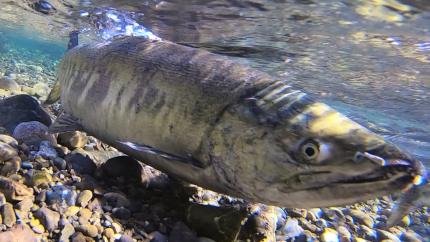
Pacific salmon perform one of the greatest wildlife migrations on the planet. Looking to spot some salmon returning home? The map below shows areas across the state where you can see salmon migrating and/or laying eggs (spawning).
If you can’t make the trip, you can still watch salmon from anywhere that you have internet by checking out our live fish and wildlife web cameras.
Salmon Viewing Tips
- Peak viewing months are between July and November.
- Approach a stream slowly and stand quietly at the edge (do not enter the water). Quick movements may cause salmon to assume you are a predator and become startled. Walking in streams while salmon are spawning may damage salmon nests with eggs (redds).
- Leave dead or dying salmon. These carcasses will provide valuable nutrients to the ecosystem and the future generation of salmon.
- Wear polarized sunglasses to help prevent glare from the water’s surface.
- Maintain control of pets so they do not catch or scare salmon.
- If you don’t see salmon, don’t give up! Try again in a few days or weeks, after rainfall, or at another location.
For even more information, check out our Nov. 2023 blog post: Where to view spawning salmon around western Washington.
Salmon Life Cycle
Pacific salmon are anadromous fish, meaning they begin their lives in freshwater streams and make their way to the Pacific Ocean where they stay for several years. After two to five years at sea, they return to the stream where they were born to lay and fertilize their eggs in a process called spawning. Some fish may travel hundreds of miles to return to their natal streams! After spawning, adult salmon may still live for several weeks and begin to slowly die and decay.
You may witness these dying salmon and hear them referred to as “zombies.” While it may be hard to watch these fish die, it’s important to know that this important life cycle has been taking place for thousands of years and provides incredibly valuable nutrients for the soon-to-be baby salmon and other wildlife and plants in their habitats.
Salmon Viewing Locations
This list of locations is not exhaustive. Different species of salmon migrate at varying times of year. Please respect park, trail, road, or river closures that may be in place for your safety and to protect fish, and do not trespass on private property. Be prepared when going to view wildlife.